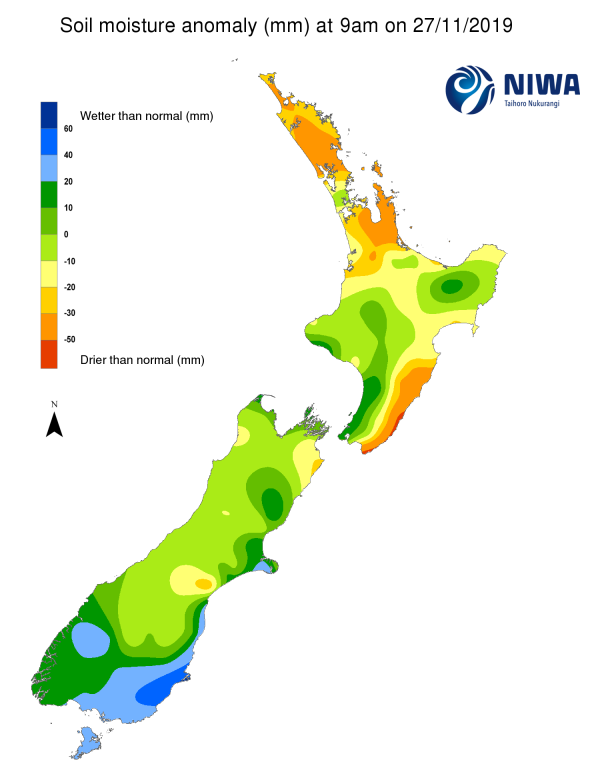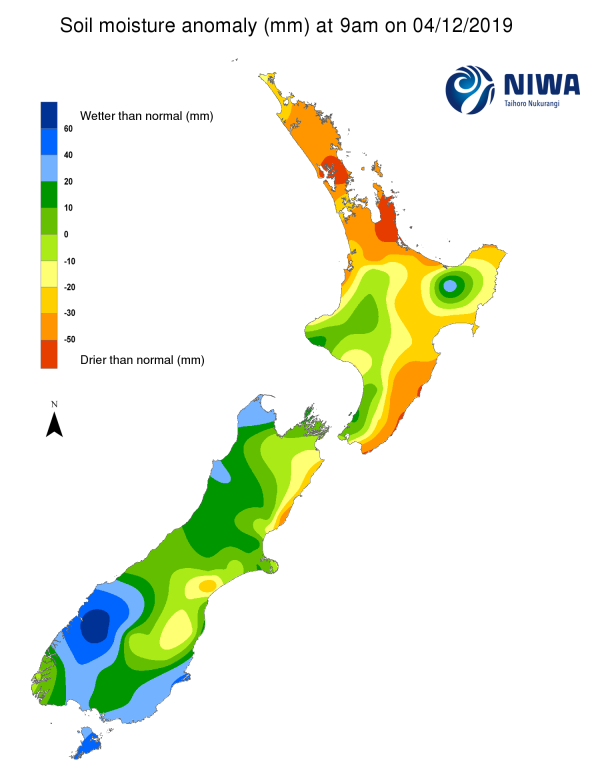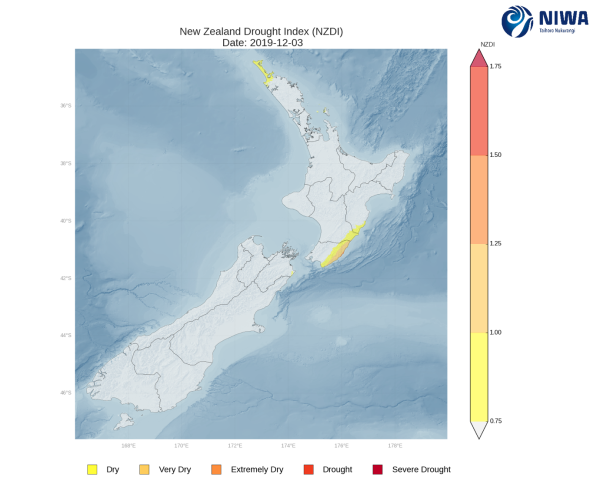A weekly update describing soil moisture across the country to help assess whether severely to extremely dry conditions are occurring or imminent. Regions experiencing these soil moisture deficits are deemed “hotspots”. Persistent hotspot regions have the potential to develop into drought.
Facts: Soil Moisture
Across the North Island, notable decreases in soil moisture levels were observed from Northland to Waikato, including the Coromandel Peninsula. Smaller decreases also occurred from Bay of Plenty to Gisborne and the Central Plateau. Meanwhile, generally little change was seen in the lower North Island. The driest soils across the North Island compared to normal for this time of the year are now found in southern Northland, northern Auckland, much of the Coromandel Peninsula, the Hauraki District, and coastal Wairarapa. The wettest soils for this time of the year are located in coastal Taranaki and the Kapiti Coast.
In the North Island, decreases in soil moisture led to expansion of hotspot coverage in the past week, particularly in the upper portions of the island. Hotspots are now in place in southern Northland, northern Auckland, Hauraki District, the eastern Coromandel Peninsula, and most of the East Coast from Mahia Peninsula south to Wairarapa.
Across the South Island, substantial rainfall during the past week led to significant soil moisture increases along the West Coast from Tasman to Fiordland, as well as in Stewart Island. Conversely, the eastern South Island generally observed light to moderate soil moisture decreases as rainfall was meagre. The driest soils across the South Island compared to normal for this time of the year are found in coastal Hurunui District, while the wettest soils for this time of the year are found in upper Fiordland and the western Queenstown-Lakes District.
Due to the recent soil moisture decreases in the eastern South Island, hotspots are now in place from the east coast of Marlborough to the Hurunui District, as well as a small portion of coastal Timaru District.
Outlook and Soil Moisture
In the North Island, after a mostly dry Friday, isolated showers and thunderstorms could affect northern areas on Saturday afternoon. On Sunday and Sunday night (8 December), a moisture-rich front will slowly move across the North Island with periods of moderate to heavy rain and the threat of thunderstorms. Rainfall totals in central and western areas could reach 30-50 mm, with 15-25 mm for the upper North Island. However, the East Coast may receive less than 10 mm. From late Monday through to Thursday (9-12 December), high pressure will produce mostly if not entirely dry weather across the entire North Island.
Areas in the central and western North Island that see the heaviest rainfall on Sunday are most likely to observe soil moisture increases in the next week, while soils in the upper North Island may remain steady or dry slightly. However, further drying is expected along the East Coast as weekly rainfall amounts may be 10 mm or less. Current hotspots along the East Coast are likely to strengthen and expand during the next week, while upper North Island hotspots may remain largely unchanged.
In the South Island, multiple rounds of heavy rain will affect the West Coast through Sunday (8 December), with totals that could exceed 100 mm in many locations. While Southland and Otago may receive 15-25 mm through the weekend, amounts in Canterbury may be less than 10 mm. After mostly dry weather early next week, a weak front on Wednesday (11 December) may produce a few more millimetres of rain in western and southern areas.
Heavy rain will cause soil moisture levels to increase further along the West Coast in the next week, while smaller increases will be possible in Southland and Otago. However, from eastern Marlborough to southern Canterbury, additional decreases in soil moisture levels are expected. This will likely result in the strengthening and expansion of current hotspots in Marlborough and Canterbury.
Background:
Hotspot Watch: a weekly advisory service for New Zealand media. It provides soil moisture and precipitation measurements around the country to help assess whether extremely dry conditions are imminent.
Soil moisture deficit: the amount of water needed to bring the soil moisture content back to field capacity, which is the maximum amount of water the soil can hold.
Soil moisture anomaly: the difference between the historical normal soil moisture deficit (or surplus) for a given time of year and actual soil moisture deficits.
Definitions: “Extremely” and “severely” dry soils are based on a combination of the current soil moisture status and the difference from normal soil moisture (see soil moisture maps)
Hotspot: A hotspot is declared if soils are "severely drier than normal" which occurs when Soil Moisture Deficit (SMD) is less than -110 mm AND the Soil Moisture Anomaly is less than -20 mm.
Pictured above: Soil Moisture Anomaly Maps, relative to this time of year. The maps show soil moisture anomaly for the past two weeks.
As of 3 December, the New Zealand Drought Index (NZDI) map below shows that dry to very dry conditions are now located across coastal Wairarapa, with dry conditions also in place in the Far North. Conditions in Wairarapa may continue to worsen in the next week due to expected meagre rainfall. Please note: some hotspots in the text above may not correspond with the NZDI map, mainly because the NZDI uses additional dryness indices including one which integrates the rainfall deficit over the past 60 days. Changes are therefore slower to appear in the NZDI compared to the instantaneous status maps of soil moisture anomaly.



